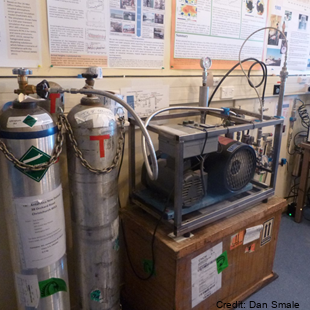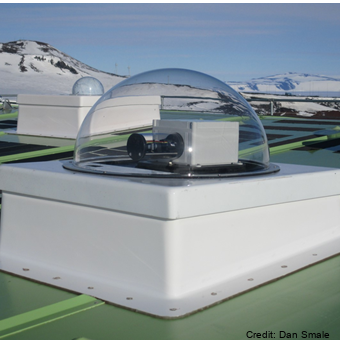TRACE GASES/TRACE SPECIES
Type of resources
Topics
Keywords
Contact for the resource
Provided by
Years
Update frequencies
status
-

Gas samples (CO2, CH4, CO, N2O, 13CO2, 14CH4, 13CO, C18O, 14CO) are collected from an inlet atop of a mast 5 metres above ground level in North sector wind conditions. Flasks and cylinders are analysed back at NIWA Greta point Gaslab. The sampling was established in November 1989. Samples are only taken when wind is from the Northerly sector and above 5kts. High pressure cylinders: ~1600psi in 30 litre cylinders and low-pressure flask samples taken (~5 litres, 25 psi in 2 litre flask). Air samples in the Cylinders & Flasks shipped to New Zealand regularly. Analysis performed at NIWA's GASLAB located at Greta Point Wellington. Analysis by Gas chromatography (GC) and isotope ratio mass spectrometry (IRMS). A semi-automated flask sampling system was installed in February 2017, allowing extra flask samples with minimal operator intervention. GET DATA: Contact Gordon Brailsford (g.brailsford@niwa.co.nz)
-

Spectroscopic measurements of stratospheric gases Nitrogen Dioxide (NO2), Chlorine Dioxide (OCIO), Bromine Oxide (BrO) and Ozone (O3) using scattered sunlight. Airyx and Envimeas: A dual MAX-DOAS UV/visible wavelength diode array spectrometer is deployed to measure of ozone (O3), nitrogen dioxide (NO2), chlorine dioxide (OClO) and bromine oxide (BrO). The instrument is a similar instrument to that of EnviMeas, and produces overlapping datasets with ADAS-2. Fixed azimuth direction, same as the Antarctic Diode Array spectrometer. System 2 (ADAS-2). The data are currently being held internally by NIWA. “Raw” data are times and recorded spectra of scattered light for several viewing directions. “Derived” data are column amount of NO2, OClO, BrO and O3, which can be split into tropospheric and stratospheric parts. This technique is sometimes referred to as MAX-DOAS Multiple-Axis Dual Optical Absorption Spectrometry. This work is carried out in collaboration the University of Heidelberg. ADAS2, Envimeas and Airyx measurements: UV/visible Multi-Axis Differential Optical Absorption Spectroscopy (MAX-DOAS) diode array spectrometers making measurements of ozone (O3), nitrogen dioxide (NO2), chlorine dioxide (OClO) and bromine oxide (BrO). JY: A scanning grating UV/Vis monochromator taking measurements of total slant column of NO2 and Ozone using scattered zenith sunlight. ADAS: A CCD grating UV/Vis grating Acton spectrometer making measurements of total slant column NO2, BrO, OClO and ozone made using scattered light zenith sunlight. Pandora: Direct sun UV/Vis measurements of ozone and NO2. Campaign to test feasibility of long term deployment at Arrival Heights. Instrument timeline JY: 1982 -2023 ADAS: 1993 - 2017 ADAS2: 1998 - present Pandora: 2015 Aug – Oct. Airyx & Envimeas : 2018 – present O3, OCIO and BrO data are in the process of being archived - please contact Richard Querel for data access. NO2 data is available via the "GET DATA" link. GET DATA: https://www-air.larc.nasa.gov/missions/ndacc/data.html?station=arrival.heights
-

Measurements of partial and total column of several atmospheric trace gases (e.g.O3, HCl, N2O, CH4, HNO3, ClONO2, HCN, HF, OCS, CO, C2H6, CFC-11, CFC-12, COF2 + others). Measurements are made with Bruker Fourier transform spectrometers, using direct sunlight (or moonlight) at infrared wavelengths (700-10000cm-1). The Bruker FTS instruments have two liquid nitrogen cooled detectors (inSb & HgCdTe) and six optical filters. For 2014-2016 seasons, operated in parallel with Bruker 120M for intercomparison studies. Bruker 120M will then be retried. Bruker 125HR will replace it. Data are routinely analysed for HNO3, HCl, CH4, N2O, CO, ClONO2, HF, C2H6, HCN, and 10+ other species measurable. Information on other trace gases is contained in the spectra, not yet analysed/retrieved. “Raw” data are times and recorded interferograms which are Fourier transformed into spectra. “Derived” data are column amounts, and in some cases limited vertical profile information, of atmospheric trace gases. Technique for vertical profile information uses "optimal estimation" to extract information from pressure broadening of absorption lines: SFIT2/SFIT4. The original solar tracker was replaced with a newer tracker in December 2017, active tracking of sun now possible. A Bruker EM27-Sun operated for a summer season at AHTS, to access capability. Measurements of total column CO2, CH4 and CO. Data archived as part of the COCCON network. Instrument timeline: - Bomen DA2 FTS 1990-1994 (HNO3 and HCl only) - Bruker 120M: 1996-2016 - Bruker 125HR: 2015 – present - EM27-Sun: Campaign based low resolution instrument (CO2, CH4 and CO only). February 2016 and then November 2020 – February 2021 GET DATA: https://www-air.larc.nasa.gov/missions/ndacc/data.html?station=arrival.heights GET DATA (EM27-Sun): https://www.imk-asf.kit.edu/english/COCCON.php
 GeoData.NZ
GeoData.NZ